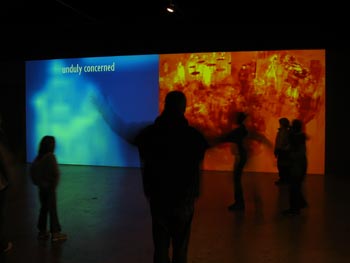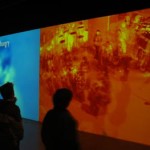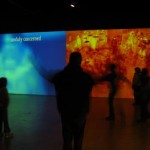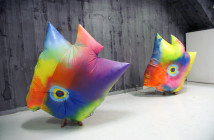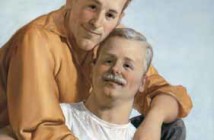Man walks into a room…
In the novel by the same title a blank room is the loose metaphor for a mind stripped of adult memory. The book ponders the stability and meaning of memory and its hold over our notions of identity. Are memories fixed or do they exist in a room-like state which we enter and leave at random?
Walking into the Media Field gallery at the Williams College Museum of Art (WCMA) immediately brought the book to mind – here was that room - with its very own looped, dysfunctional memory and subjectivity.
A small enclosed gallery off of WCMA’s historic rotunda, Media Field is the museum’s sacred space for video and new media work. The Toronto based artist, David Rokeby has inhabited it with his video installation Taken, specifically reformatted for the space. The work establishes a surveillance environment that monitors the room with a three-channel video projection, tracing the memory of the gallery, so to speak. Rokeby’s software responds to every visitor by focusing and recording their movements in a looped video format on three walls, leaving the center of the gallery lit up and empty in wait for a performance. That performance is your blurred image within a stream of transparent bodies flowing through the room [the day’s palimpsest of visitors]featured in the main projection. Once a new presence is detected the crowd vanishes and the new visitor is isolated in the space. Walking into the room gets you noticed – quickly- and just as quickly, you are stitched into the quilt of the gallery’s daily memory. [Taken is rebooted every day or so, so we can say this is the gallery’s short term memory]. On the opposite wall just your head is captured and placed within a grid of grayed out portraits - Brady Bunch style. Every once in while a face will fill the entire projection and Rokeby’s system will generate a random adjective above it in large lettering. I was quite pleased with my “Critical.” The third, and less engaging image, lies between the two and generates a simple relief image of your form in a slow-rolling reel of green-grey.
The installation can easily become sinister - we are watched and judged by Taken and then splayed on the walls for display. But here Rokeby’s interest in surveillance is tightly focused on the museum - evoking the security systems of such an institution as well as its ultimate mission to provide a place for looking [at art]. At WCMA, Taken is modified from its original floor-to-ceiling format to neatly fit into the wood moldings of the room and in one instance, above a fireplace. Held above eye-level, the projections’ placement likens them to large paintings set in a traditional gallery format.
By giving the viewer a certain amount of agency – we can leave the room and eventually be wiped out of the software’s memory- Rokeby makes visible the delicate exchange between art and its viewers. His work stems from the notion that all art is in someway interactive since, ultimately, the spectator completes the work - a notion rooted in the postmodernism of Duchamp. Acknowledging the viewer, Taken evokes the softer side of technology. And as I stood in the room, watching my video self in a swarm of virtual museum visitors there was a sense of community and comfort.
The sensation of watching yourself being watched as you are watching…etc… is a very media-friendly postmodern nod to a scattered subjectivity. Yes- our media-saturated society has thoroughly fragmented the image of ourselves into one thousand shards- none of which can ever show the true self nor be placed back together again. The eggshell is broken. A well repeated trope, but Rokeby’s comfort and skill in technological media acknowledges this division between our physical selves and projected selves in a way that creates a subtle, intriguing experience. Taken was thoughtfully curated by Cara Starke with Lisa Dorin and an accompanying pamphlet is available for those who want to take home a snapshot of the event.
The swarming virtual crowd of Taken links nicely to the video work by Michal Rovner at the other end of the museum. Order(2003), is populated with Rovner’s ghostlike, digitized people – actual video footage abstracted to black silhouettes - marching in a looped format that converges at the center of the screen. The result is a kaleidoscopic patterning of these silhouettes that crowd and disperse against the muttering of background noise. Rovner’s Israeli nationality adds a political element to the work - are these protesters? Is that figure in the back in a chador? Are they protesting for or against Israel? But it is also Rovner’s inclusion in the traveling exhibition Beyond East and West: Seven Transnational Artists that adds the overt political-middle eastern dimension. Organized by the Krannert Art Museum in Illinois, the unfortunately titled show is an impressive collection of artists who are all from the Middle East [the borders have been defined as the area from Egypt to Pakistan]and work with particularly elegant aesthetics in their cross cultural works. Ghada Amer, Shahzia Sikander, Mona Hatoum, Y. Z. Kami, Jananne Al-Ani, Walid Raad, and Michal Rovner are the featured seven. Though Shahzia Sikander’s Pakistani mixture of traditional miniature painting with contemporary political figures is the most direct fusion of two distinct visual cultures–the entire group manages this feat in some intelligent way or another. Dutch painting, minimalism, lesbian porn and archiving all find their way into these globe trotting conversations. The exhibition works to dispel the notions of “East” and “West” but in fact shows us the ways in which the two outdated notions combine into good artwork.
WCMA is the last venue for Beyond East and West. Rokeby’s work The Giver of Names was featured in the group show eVolutionat Art Interactive in Cambridge last year- but if you’re heading west to see the glory of all that is North Adams, Trade Show and Cia Guo-Ciang’s rolling Ford Tauruses- you must make a stop at WCMA.
- Two views of Taken by David Rokeby – video projection/installation, 2005
Links:
Williams College Museum of Art
"David Rokeby: Taken" is on view insert until June 12th at the Williams College Museum of Art located at 15 Lawrence Hall Drive, St. Rt. 2 in Williamstown, MA.
All images are courtesy of the artist and Williams College Museum of Art.

